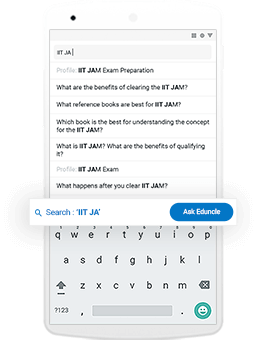Time management is very much important in IIT JAM. The eduncle test series for IIT JAM Mathematical Statistics helped me a lot in this portion. I am very thankful to the test series I bought from eduncle.
Nilanjan Bhowmick AIR 3, CSIR NET (Earth Science)- IIT JAM
- Chemistry (CY)
Why elecyrophilic attack take place more easily on double bond than triple bond?
why elecyrophilic attack take place more easily on double bond than triple bond?
- 0 Likes
- 4 Comments
- 0 Shares
-
![comment-profile-img]() >
>
Priyanshu kumar Best Answer
Alkenes are more reactive than alkynes towards electrophilic addition reaction. This is due to formation of highly strained bridged carbocation (3 member ring with a double bond). Also, the C atom in alkynes is more electronegative (more s character) due to which, it tightly held pi electrons.
![eduncle-logo-app]()
Alkynes form a vinyl carbocation as an intermediate in electrophillic addition reactions. Vinyl carbocations are unstable compared to the carbocations formed during the electrophillic addition reactions of alkenes. So, alkenes react faster than alkynes towards electrophiles.
![eduncle-logo-app]()
got this shifana??
![eduncle-logo-app]()
if you have any doubt in this then please ask😊🙏
-
Suman Kumar
The triple bonds of alkynes, because of its high electron density, are easily attacked by electrophiles, but less reactive than alkenes due to the compact C-C electron cloud
![eduncle-logo-app]()
https://www.google.com/url?sa=t&source=web&rct=j&url=https://chemistry.stackexchange.com/questions/42720/why-does-bromine-add-to-a-double-bond-instead-of-a-triple-bond-if-both-are-prese&ved=2ahUKEwi6z56w-u7qAhUC8XMBHRtYBowQFjAMegQICRAB&usg=AOvVaw1FDDZY_MslsYykJAfopVnI&cshid=1595905679767
![eduncle-logo-app]()
Go through this link
![eduncle-logo-app]()
https://www.google.com/url?sa=t&source=web&rct=j&url=https://www.zigya.com/study/book%3Fclass%3D11%26board%3Dhbse%26subject%3DChemistry%26book%3DChemistry%2BPart%2BII%26chapter%3DHydrocarbons%26q_type%3D%26q_topic%3DAromatic%2BHydrocarbon%26q_category%3D%26question_id%3DCHEN11094551&ved=2ahUKEwi6z56w-u7qAhUC8XMBHRtYBowQFjARegQIAhAB&usg=AOvVaw1wpqTdKwDd67Z1KWYR_lZl&cshid=1595905779087
![eduncle-logo-app]()
shifana did you get this now
![eduncle-logo-app]()
please ask if you don't get anything 🙏
-
![comment-profile-img]() >
>
Dinesh khalmaniya 1
![best-answer]()
the orbital overlap places the electron density directly between the nuclei of the two C atoms combining. This gives a strong bond so the bonding molecular orbitals are low energy while the antibonding levels are high. The only method of attack is via the empty antibonding MOs. An alkyene has one sigma and one pi bond between the two C atoms. The pi bonds use p orbitals overlapping side on placing the bonding electron density above and below the connection line between the two nuclei. This is a less stable bond, so the bonding MO is not as low in energy as the sigma are, consequently the antibonding pi MO is not as high. This allows an attacking reagent (electron rich looking for a vulnerable nucleus) to more strongly occupy the Pi ABMO than it could a sigma ABMO. Also the pi BMO is much more vulnerable to elctrophilic attack than the sigma BMO. An alkyne has two such pi-bonds plus the sigma bond, making it also vulnerable to nucleophilic attack into the pi ABMOs, but is also electron rich with two pairs of electrons in weaker bonds, so it is also more susceptible to electrophilic attack. Of course as far as C-C bond strength is concerned, a single bond is still weaker than a double and both are weaker than a triple bond. It is the susceptibility to attack (or activation energy of the intermediate state) which becomes important.
![eduncle-logo-app]()
got it??
![eduncle-logo-app]()
please accept the answer if you got it 🙏🙏
Do You Want Better RANK in Your Exam?
Start Your Preparations with Eduncle’s FREE Study Material
- Updated Syllabus, Paper Pattern & Full Exam Details
- Sample Theory of Most Important Topic
- Model Test Paper with Detailed Solutions
- Last 5 Years Question Papers & Answers
Sign Up to Download FREE Study Material Worth Rs. 500/-










 >
>

 >
>








Shifana
ys.. thnks